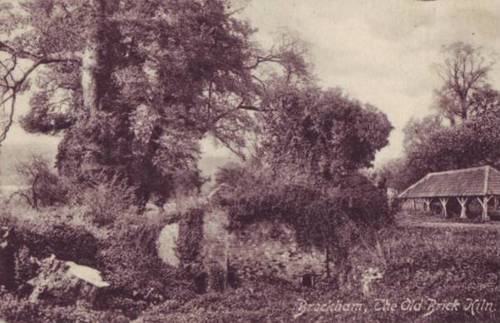Lime Burning
Lime Burning
Chalk is a form of calcium carbonate which when burnt at about 900 degrees C becomes quicklime (calcium oxide). If water is added it becomes slaked lime (calcium hydroxide). Lime putty is made by adding an excess of water to quicklime. Hydrated Lime was being made at most lime works by the 1950's. Lime putty was used for mortar and plaster, the slaking being done on site. Slaked lime is used as fertilizer, restoring calcium to the soil, and for building. Quicklime has less pleasant associations, being used to dispose of bodies, particularly in plague pits.
Lime burning goes back to pre-history. In Britain it was done in Roman times to provide mortar. There are Saxom references to lime and mortar and in the 12th Century, walls were limewashed with lime. It was often made in pits and a clamp using a method akin to charcoal burning and little evidence has been left.
By medieval times limekilns were used to produce lime for mortar and by the 16th century limekilns were temporary structures, built for immediate demand and then allowed to collapse or to be partly rebuilt for the next firing. The agrarian revolution of the 18th century caused an enormous demand for lime and a vast number of kilns were built. If it was relatively easy and economically viable to have chalk delivered from the quarry they made their own lime. Canals later improved transport.

The old brick kiln
The industrial revolution resulted in blocks of kilns being built, capable of continuous production. By the 20th century mass production had become concentrated at the larger limestone quarries and chalk pits, with economical distribution being made by the railways. The introduction of Portland cement reduced the demand for simple lime mortar.
With the parallel lines of the North Downs and the Greensand Surrey has produced firestone, hearthstone and chalk for many centuries. As long ago as 1359 John and Philip Prophete were appointed masters of the quarries at Merstham and Chaldon. They were given Letters Patent to dig stone for Windsor castle and the sheriff was given powers to take any necessary action against any who 'refused to assist in the work'. In 1805 the best limestone pits in the county - possibly 'in thekingdom' - were considered to be at Dorking. The chalkstone quarries then worked were at Godstone, Caterham, Reigate, Merstham, Buckland, Effingham, West Horsley, Clandon, Guildford and Puttenham. To produce lime six loads of chalk were needed per kiln and this would cost 15/- to 21/-, but the cost to the customer was between £10 to £15, representing the cost of fuel and particularly, that of transport. The railways brought this price down, but it was still cheaper for farmers near chalk pits to have the raw material delivered and make their own lime.
The kilns had sandstone walls, brick lining for the pot and a front wall, a single arched draw-hole. A ledge ran around the inside and a wooden frame or iron horse helped the formation of the initial load of chalk, which would form a dome. Smaller pieces of chalk were added. A fire was lit under the dome, a modest heat first to dry and set the charge, and then a fierce heat was applied until calcining was complete in 24 to 36 hours, indicated by a clear red fire at the top. After a lengthy cooling period the lime was drawn out. Long handled tools were used for raking and clearing ashes. The complete operation took probably four or five days. The fuel could be a mixture of coal and wood, but locally, in a wooded area, it would be brushwood, coppiced wood or furze.

